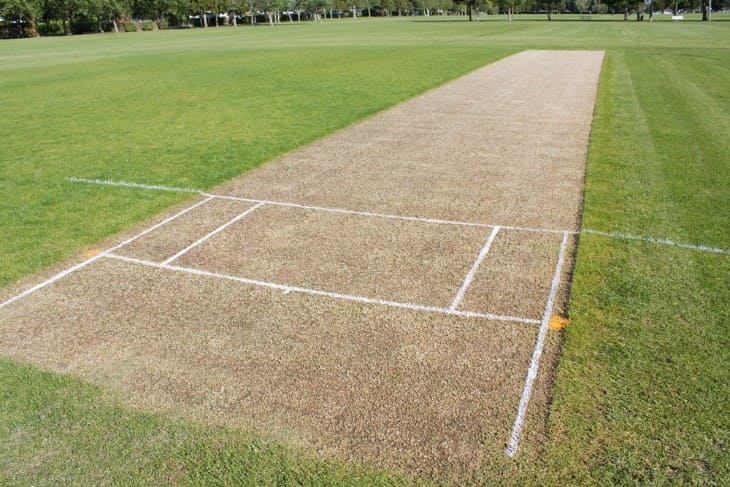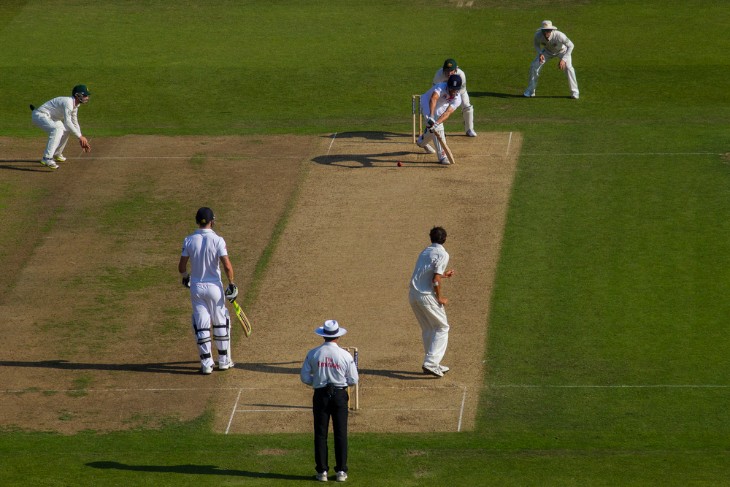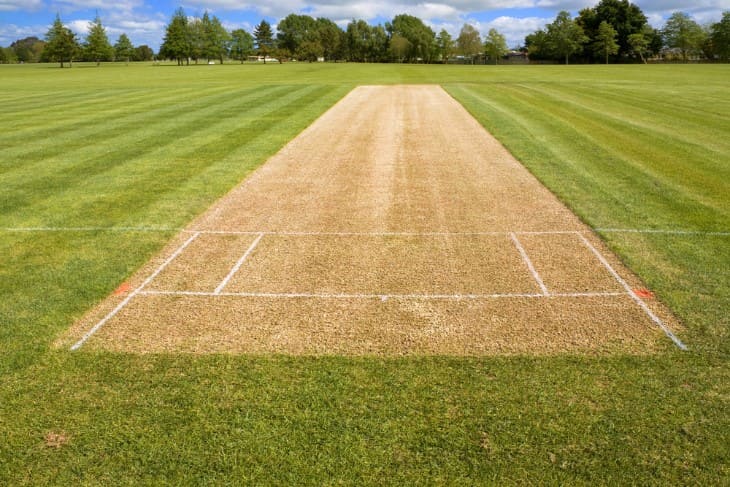Delving into the intricate world of cricket, the fundamental question arises: "How long is a cricket pitch?" Beyond its apparent simplicity lies the essence of the sport, encapsulating the strategic significance of this 22-yard (20.12 meters) strip. In the realm of cricket, the pitch stands as a meticulously prepared and maintained surface, serving as the focal point where the clash between bat and ball unfolds. Its dimensions not only define the playing area but intricately shape the dynamics of the game, influencing strategies, and highlighting the nuanced interplay between players and the environment in which they compete.
The Basics of a Cricket Pitch
Definition and Purpose of a Cricket Pitch
The cricket pitch is a critical element at the heart of the game, serving as the primary stage for the battle between the batsman and the bowler. It is a rectangular strip of compacted soil or clay that forms the central portion of the cricket field. This strip, 22 yards (20.12 meters) in length, is where the majority of action unfolds. Its primary purpose is to provide a fair and even surface for both batting and bowling sides.
Key Components and Markings
Within the cricket pitch, several key components and markings are crucial to gameplay. Three vertical wooden posts, known as stumps, are placed at each end of the pitch, forming the wicket. The area where the batsman stands is demarcated by the popping crease, a white line perpendicular to the stumps. Behind this crease, the return crease extends, measuring the bowler's delivery stride. Additionally, the pitch also contains markings for the bowler's run-up area and other essential zones.
Dimensions and Specifications
As defined by the Laws of Cricket regulated by the International Cricket Council (ICC), a standard cricket pitch measures precisely 22 yards in length and 10 feet in width. This standardized size ensures uniformity across the game. The accurate positioning of the stumps, creases, and other markings is integral to maintain the game's fairness and adherence to cricketing regulations.
Understanding these foundational elements is crucial for players, umpires, and spectators. The pitch's dimensions, its evenness, hardness, and sometimes grass coverage significantly impact the game. The behaviour of the cricket ball on the pitch dictates gameplay strategies, making it an essential factor in the dynamics between batsmen and bowlers. A pitch's condition can vary widely, influencing the pace, bounce, and movement of the ball, thus challenging players to adapt their strategies accordingly.
Standard Measurements and Dimensions
Standard Size and Specifications
A cricket pitch, conforming to international standards, is precisely 22 yards (20.12 meters) in length from one set of stumps to the other. This standardized length is a crucial constant across various formats of the game, including Test matches, One Day Internationals (ODIs), and Twenty20 (T20) cricket. Additionally, the pitch's width remains consistently 10 feet (3.05 meters) across all formats, ensuring uniformity in the playing surface.
Variations in Pitch Sizes Among Formats
While the length and width of the pitch remain constant, certain variations in the pitch conditions and characteristics are witnessed across different cricket formats. In Test cricket, where matches can span up to five days, the pitch tends to evolve and display more wear and tear over the course of the game. This evolution influences factors such as spin, bounce, and deterioration of the pitch, leading to varied challenges for batsmen and bowlers.
In comparison, limited-overs cricket, particularly T20 matches, often features pitches that might be more conducive to aggressive strokeplay. These pitches might have lesser wear and offer more consistent batting conditions throughout the match duration due to their shorter nature. ODI pitches, falling in between Tests and T20s in terms of duration, also have their unique characteristics that cater to both batting and bowling strategies.

Historical Evolution of Cricket Pitch Dimensions
The standardization of the cricket pitch's length and width has undergone evolutionary changes over the history of the sport. In the early days of cricket, pitches were considerably shorter in length, and variations were more prevalent. Over time, a consensus was reached, leading to the establishment of the current standardized measurements as defined in the Laws of Cricket.
Understanding these standard measurements and their variations across formats is essential for players, coaches, groundsmen, and cricket enthusiasts. It highlights the nuanced impact that pitch dimensions have on gameplay strategies and the challenges posed to players in adapting to different pitch conditions, thereby enriching the essence and diversity of the sport.
Construction and Maintenance
Construction of a Cricket Pitch
The construction of a cricket pitch involves meticulous preparation and adherence to specific guidelines to ensure a fair and consistent playing surface. The process typically begins with the selection of the site, where the ground is levelled, and the soil composition is evaluated. The chosen area undergoes rigorous preparation, including removing any existing turf, debris, or unwanted vegetation.
Next, the soil undergoes a series of treatments, which may involve adding clay or loam to achieve the desired texture and firmness. It's crucial to create a balanced surface that provides adequate support to the ball while allowing for controlled bounce and spin variations during gameplay. Groundsmen and pitch curators play a pivotal role in overseeing this construction phase to ensure the pitch meets the necessary standards.
Maintenance Practices
Maintaining a cricket pitch is an ongoing process that requires dedicated care and attention. Groundsmen employ various maintenance practices to uphold the pitch's quality and consistency. Pitch rolling is a fundamental aspect wherein heavy rollers are used to compress the soil, providing the required firmness and stability while also aiding in uniform bounce.
Watering the pitch is another critical maintenance practice. Proper irrigation helps in keeping the surface moist enough to prevent excessive wear and tear during matches, ensuring a balance between hardness and softness. Additionally, covering the pitch when not in use shields it from adverse weather conditions, preserving its integrity.
Challenges and Expertise
Maintaining a cricket pitch presents several challenges. Balancing the pitch's firmness and moisture content, especially in varying weather conditions, is crucial to ensure fair gameplay. Moreover, ensuring that the pitch offers consistent conditions for both batting and bowling sides is a delicate task requiring expertise and experience.
Pitch curators and groundsmen possess a wealth of knowledge and expertise accumulated over years of experience. They closely monitor the pitch's condition, taking into account factors such as weather, wear and tear, grass coverage, and the nature of the soil. Their understanding of these nuances helps in making informed decisions regarding pitch maintenance, contributing significantly to the quality of cricket matches held on those surfaces.
Understanding the intricacies of constructing and maintaining a cricket pitch sheds light on the meticulous efforts invested in providing a conducive playing surface. The commitment to ensuring fair and challenging conditions for players underscores the importance of pitch care in upholding the essence and competitiveness of the sport.
Significance of Pitch Dimensions in Gameplay
Impact on Batting and Bowling Strategies
The dimensions and conditions of a cricket pitch play a pivotal role in shaping the strategies employed by batsmen and bowlers. The length of the pitch, 22 yards (20.12 meters), influences the time it takes for the ball to reach the batsman after being bowled. This, combined with the pitch's surface characteristics, affects the pace, bounce, and movement of the ball, influencing how batsmen approach their shots.
For bowlers, the pitch dimensions determine their delivery strategy. A longer pitch may allow for more variations in length, creating opportunities to exploit bounce or seam movement. Additionally, bowlers assess the condition of the pitch to determine the ideal areas to bowl, taking advantage of any unevenness or rough patches that could aid spin or swing.
Behaviour of the Cricket Ball
The behaviour of the cricket ball on the pitch is a product of its dimensions and surface conditions. The hardness or softness of the pitch, the presence or absence of grass, and variations in moisture levels significantly impact the ball's trajectory. Pitches that offer more bounce and carry can favour fast bowlers, while pitches conducive to spin might aid spinners in generating turn and deception.
Home Ground Advantage and Adaptability
Teams often develop a stronghold on their home ground, understanding the nuances of the pitch and its behaviour. Such familiarity gives the home team an edge in strategizing and adapting their game plans accordingly. Conversely, visiting teams face the challenge of adapting quickly to unfamiliar pitch conditions, which adds an extra dimension to the game.
Influence on Match Results
The pitch dimensions and conditions have a direct correlation with the match's outcome. A pitch that offers assistance to both batsmen and bowlers tends to create a balanced contest between bat and ball, often resulting in closely fought matches. However, pitches that heavily favour one aspect over the other might produce high-scoring games or matches dominated by bowlers, altering the expected course of the game.

Pitch Length in Comparison to Other Sports
Cricket Pitch Length vs. Other Sports' Field Dimensions
Cricket vs. Soccer (Football):
A cricket pitch's length measures 22 yards (20.12 meters), significantly shorter than a standard soccer field. A soccer field's length ranges from 100 to 130 yards (91.4 to 118.9 meters) in international matches, making it much larger than a cricket pitch.
The difference in dimensions reflects the nature of the sports; cricket, with a shorter pitch, focuses on a confined area where individual battles between bowler and batsman take place. Soccer, on the other hand, requires broader spaces for team movement and strategic play.
Cricket vs. American Football:
An American football field is approximately 120 yards (109.7 meters) in length, five and a half times longer than a cricket pitch. This vast difference highlights the contrast in gameplay dynamics.
American football, characterized by short bursts of intense play, involves the strategic placement of players over a more extended field. In contrast, cricket's shorter pitch focuses on precise battles between bowler and batsman within a confined area.
Cricket vs. Baseball:
Baseball's diamond-shaped field features a distance of around 90 feet (27.4 meters) between bases, much shorter than a cricket pitch. However, the outfield dimensions in baseball can be quite extensive, varying across different stadiums.
Both cricket and baseball involve ball-and-bat gameplay, but the distances covered and the strategies employed differ significantly due to the varying field dimensions.
Importance of Dimensions in Sports
The dimensions of a playing surface directly impact gameplay strategies, tactics, and the nature of competition in each sport. While some sports, like cricket, emphasize individual duels in a specific area, others, like soccer and American football, involve broader spatial dynamics where team strategies and movements across the entire field play a significant role.
Understanding these differences highlights the diverse nature of sports and the significance of field dimensions in shaping the gameplay and strategies employed by athletes. Each sport's unique field dimensions contribute to its distinctive challenges, strategies, and entertainment value for players and spectators alike.
Summary
The question "How long is a cricket pitch?" unveils the pivotal role played by this 22-yard (20.12 meters) strip in the sport of cricket. Beyond its mere dimensions, the cricket pitch stands as the battleground where batsmen and bowlers engage in a captivating duel. Its carefully constructed surface, coupled with maintenance practices, influences the pace, bounce, and behaviour of the cricket ball, fundamentally shaping the strategies employed by players. Contrasting its length with other sports' field dimensions accentuates the unique nature of cricket's confined yet crucial playing area. Understanding the significance of a cricket pitch's dimensions underscores its profound impact on gameplay dynamics, reflecting the intricate relationship between the playing surface and the strategies executed within it.
For more information:


